|
Teapots
By Unjeria C. Jackson, M.D.
Posted April 2017

The vessel for brewing tea,
Elegant
And
Perfectly proportioned;
Oh, how delightful
to
Take tea and
Scones
in the afternoon!
©Unjeria C. Jackson, M.D.
A teapot is defined as a vessel which has a handle, spout and lid for making and serving tea. But a teapot is so much more than that description. There would be no discussion about teapots without the discovery of tea. It has been stated that tea was mentioned as early as the Zhou Dynasty which ended in 222 BC. The more popular belief about the discovery of tea is that the Chinese Emperor Shen Nung discovered tea around 2700 BC. The first book on the subject of tea, The Ch’a Ching, was not printed until 870 in China. Tea had been discovered more than 3,000 years before, but the first teapot was not produced until around 1492.
|
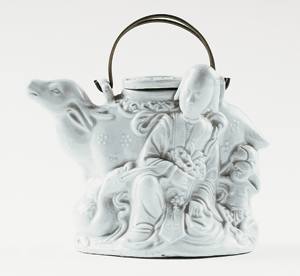
|
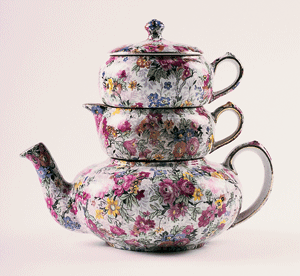
|
|
Chinese Blanc de chine teapot with wire handles and
stylized man with animal figures, ca. 1810-1830.
|
English stacking chintz tea set,
Nelsonware, ca. 1930.
|
Even though teapots as we know them today have only been around for 525 years, there have been vessels for brewing and drinking tea for much longer. For many years, tea was in the form of bricks. A piece would be cut off and placed into a handle-less vessel, or cup, where it was brewed with boiling water and sipped from that same cup.
This method continued to be used when tea was brewed in powder form. During the Sung Dynasty (960 to 1279), tea leaves were pounded into a fine powder. This was whisked with a bamboo brush after boiling water was added. In the late 14th century, there was even greater interest in drinking tea because processed tea leaves were being steeped. The processed leaves reduced the bitterness and enhanced the flavor of the tea.
|
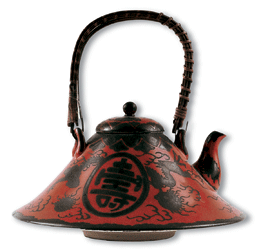
|
Rare pyramid-shaped Kutani teapot, 5 inches high with dragon motif and wrapped wooden handle.
|
It is believed that the initial shape and style of teapots may have been influenced by Chinese wine ewers or ceramic kettles. Another possibility is that Islamic coffee pots were being imitated. Whatever the original influences were for the teapot, there have been amazing changes in the style and materials used in the production of teapots. Over the years, teapots have ranged from purely practical to pretty and practical to pure works of art with or without functionality. Teapots come in a numerous array of shapes and sizes and have been made from many different types of materials, including pottery, porcelain, silver, cast iron, glass, wood, pewter and other metals. A brief history about teapots and some examples are presented in this article.
The first teapots were produced in the YiXing potteries in China around 1492. The YiXing or “purple” clay (also called zisha) was porous and left unglazed. The teapot became “seasoned” with the particular tea that was brewed in it. These teapots served the dual purposes of brewing and drinking. Around this time, the drinking of tea was transitioning from primarily for medicinal purposes to ceremonial proceedings. During the Japanese tea ceremony, or chanoyu, red clay teapots and tea bowls were used.
|
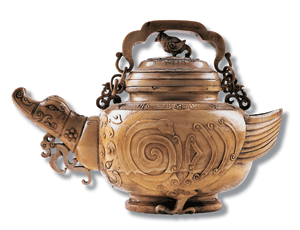
|
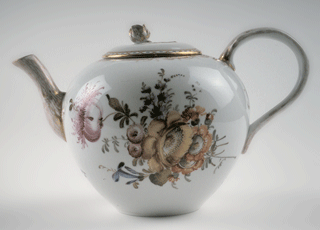
|
|
Carved ivory teapot, stylized bird, 4.5 inches high, ca. late 18th century to early 19th century.
|
Meissen teapot with vividly painted flowers
and rose finial,
ca. 1860s.
|
Towards the end of the Ming Dynasty, around the mid-17th century, the drinking of tea was becoming more widespread. As tea drinking became more relaxed in Japan, cast iron teapots, or tetsubin, were used to brew and serve tea. More people were drinking tea for pleasure.
As tea went from China to Europe at the end of the 17th century, teapots were also imported. These porcelain teapots were mostly in blue and white underglaze. European potters were eager to make their own teapots. The hard paste formula porcelain was made by Ehrenfried Walther von Tschirnhaus in Dresden, Germany, in 1708. This led to more creativity and new styles and designs. The Meissen Factory opened in 1710 and still produces today.
It has been acknowledged that China gave us tea, but that the gift of teapots is from England. Once the British mastered the art of making porcelain that did not shatter when boiling water was added, they made and continue to make some of the best china. Porcelain is made of pure white clay and crystalline minerals and is fired at very high temperatures. Hard paste porcelain is made of pure white clay (kaolin) and china stone crystalline mineral (petuntse), which is found only in China. Soft paste porcelain is made with fine clay and glass-type substances. Bone china is made by adding calcified animal bone ash to petuntse and kaolin. There are many ceramic and porcelain manufacturers in England including but not limited to: Coalport Porcelain, Davenport Pottery, Leeds Pottery, Minton, Royal Doulton, Royal Worcester, James Sadler and Sons, Josiah Wedgwood, Shelly Potteries, Spode and Wedgwood.
|
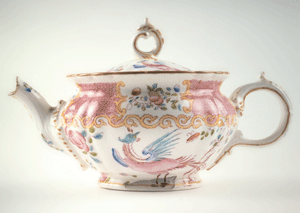
|
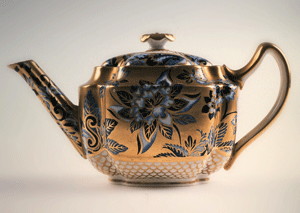
|
|
Minton pink cockatrice pattern teapot,
4.5 inches high, ca. 1890.
|
Copeland Spode teapot in gold with
blue and white flowers,
ca. 1900.
|
The influence of Catherine of Braganza on the consumption of tea in Britain is documented. As the affluent participated more in the drinking of tea, silver tea services were a must-have. The less affluent had to settle for pewter. When afternoon tea became fashionable, thanks to Anna Russell, 7th Duchess of Bedford and lady in waiting for and friend to Queen Victoria, all of the tea ware and accoutrements necessary were increasingly manufactured, beginning around the mid-18th century.
Teapots have been made in many types of metal other than silver. Examples can be found in cast iron, pewter, brass, aluminum, copper, tin, stainless steel and chrome. The 20th century saw the popularity of glass teapots increase. They are particularly lovely for observing tea brewing, especially when a flowering tea is being steeped. Less commonly seen are teapots made out of wood, but some have been around for a while.
|
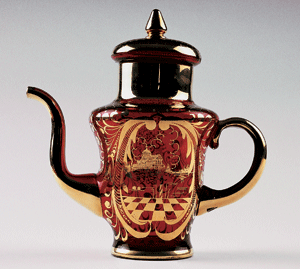
|
Venetian red glass teapot hand painted
with gold, ca. 1930s.
|
Various factors are used to identify and date teapots. The shape, color, decoration and the presence or absence of a maker’s mark all help in the identification and dating process. Additionally, teapots imported to the USA before about 1898 were not required to be marked with the country of origin. Therefore, that information may not be present. From 1898 to 1918 teapots imported to the USA had to be marked with the country of origin. After 1918, the teapot had to be marked with “made in” the country of origin.
The teapot may have been invented out of necessity, but it clearly developed very early into a form of artistic expression. Even the most basic teapot has shape, texture and color. The parts of the teapot, such as the handle, lid and spout, provide additional elements to improve function and/or enhance artistic design. Functionally, the inner spout of the teapot may have a strainer (which distinguishes it from a coffee pot) to hold back the leaves. The lid may have a small hole to allow the steam to vent. Teapots have also been made for advertising and as souvenirs.
Over the years, artists have created masterful works of art only limited by their imaginations. At the same time, some of the more elaborate and unusual teapots are created at the expense of utility, but they are unique works of art. Teapots will always be appreciated for their practical use and artistic pleasure.
------------------------------------
Dr. Unjeria Jackson has been a tea drinker since childhood. She began collecting teapots about 23 years ago and now has about 1,800 teapots. She has given lectures to numerous groups and hosted many afternoon teas in her home. There was an exhibition of some of her teapots and a series of lectures by Dr. Jackson about her collection and the history of tea at the Morris Museum in Morristown, N.J. in 2011. To see many more examples of all of the varieties of teapots discussed in the article, refer to the author’s book, Teapots by Design - A Collector’s Catalogue, published by Schiffer.
|